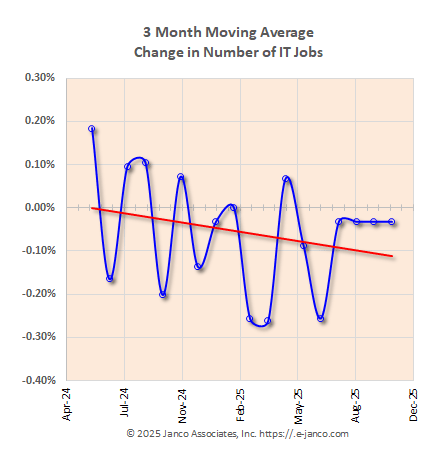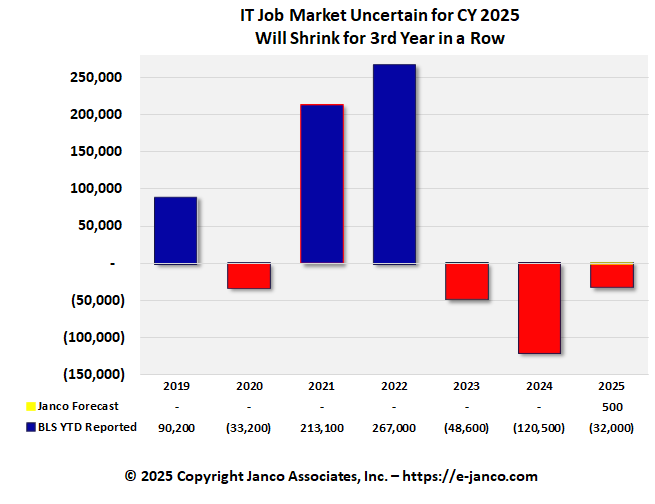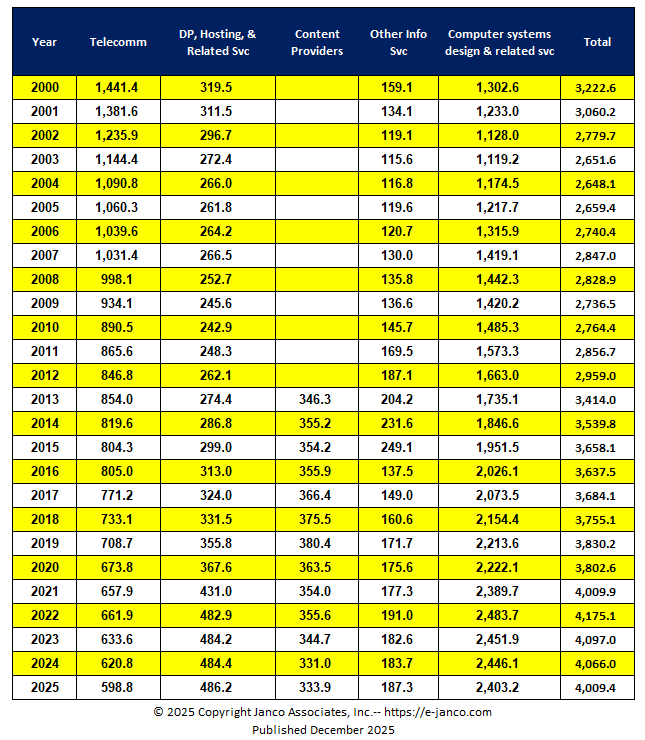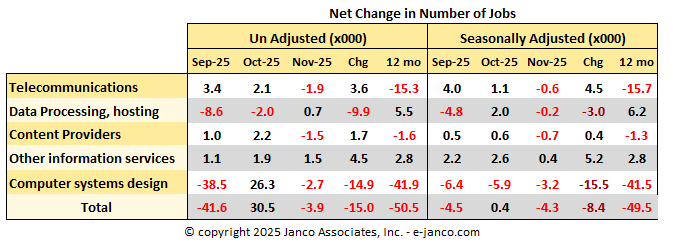Information Technology Employment News
IT total number of jobs declines one more time - for the second month in a row there was a net loss in the number of IT jobs!
(note - Charts have been updated with the latest data. If you want to see the original charts please contact support at e-janco.com. Text is the original text. Specify which charts and dates you desire and they are available for free to paid subscribers of the CIO - IT Manager Newsletter)
Updated
IT Pros Hiring Picture Mixed

Layoffs abound and there no longer is robust hiring trend for IT Professionals - the economy is slowing. However, there are a number of jobs unfilled by IT Pros. The primary culprit is the lack of qualified individuals to fill the open positions. In our opinion, the IT Job Market is currently at no growth!


The number of unfilled jobs trend line is down as the economy softens and CIOs and CFOs look to control costs and eliminate requisitions for positions that cannot be filled. There was a major pullback of the number of excess jobs for IT Pros - layoffs have impact on number of unfilled jobs available for IT Professionals.
Subscribe to our Newsletter to get this information delivered to your inbox as soon as it is released. SUBSCRIBE
Information Technology Employment News - There was a net loss of 300 IT jobs in December, according to the latest Bureau of Labor Statistics data. The primary driver was the telecommunications sector (4,100 jobs lost) while jobs were gained in other information services (1,300 jobs added), data processing and hosting (2,000 jobs added), and computer system design and related services (500 jobs added).
For the last three months there has been a net decrease of 800 jobs including the effects of the termination of the Verizon strike included in the data, a Janco Associates report noted. The CEO of Janco, M.V. Janulaitis said companies are continuing to watch expenses and IT seems to be a function that continues to be the focus of these efforts in many organizations.
“IT is often viewed as a cost center putting head counts and capital budgets under constant scrutiny. IT jobs are typically not being cut, rather openings are left unfilled,” he said. “Some Chief Information Officers (CIOs) are feeling continued pressure to control costs and are looking ahead to delay 2012 hiring and projects as they begin to push those expenses back until the 3rd and even 4th quarters. ”
Employment is on the rise in health care IT and spending will reach $40 billion by the end of this year, the report projected. Much of that growth will come from spending on electronic health record (EHR) systems, mobile health applications and efforts to comply with new government standards. Boosted by increased spending on health care software--which is needed for the rollout of EHR systems--the U.S. health care IT market is expected to grow at a rate of about 24 percent per year from 2012 to 2014, the study said.
Spending on health care software rose 20.5 percent in the past year, from $6.8 billion in 2010 to a projected $8.2 billion this year. Recent mergers and acquisitions in the health care IT market also point to growing private-sector interest in software, which will see sales grow at a rate of more than 30 percent annually from 2012 to 2014.
In Janco's Salary Survey, Janco reports that salaries have remained flat in large organizations, and on the bright side, a slight increase in mid-sized and small enterprises. The Labor Department has reported the economy added 200,000 jobs in December, 120,000 jobs in November and 80,000 in October. This continues to be lower than the number of jobs needed for the U.S. economy to stay even with adult population growth, Janulaitis noted.
Employment grew in the second and third quarters despite very slow gross domestic product (GDP) growth because labor productivity fell the first half of 2011. Consequently, real wages, per capita income and living standards are dropping--all exacerbated by hungry state and local tax collectors who refuse to tighten belts as quickly as households and businesses.
Employment grew in the second and third quarters despite very slow GDP growth because labor productivity fell the first half of 2011. Consequently, real wages, per capita income and living standards are dropping - all exacerbated by hungry state and local tax collectors who refuse to tighten belts as quickly as households and businesses.
IT Job Market Employment Trends
IT Hiring Plummets IT Unemployment Rate 5.0% InNovember

The latest data for more read on...
Note - data includes the adjustments by the BLS to the initially reported data.Subscribe to our Newsletter to get this information delivered to your inbox as soon as it is released. SUBSCRIBE
Historic IT Job Market Size - 4.01 Million Employed as IT Pros

This is not the original data that was published.
It has been updated with data complied by Janco Associates with data as of September 2025.
Subscribe to our Newsletter to get this information delivered to your inbox as soon as it is released. SUBSCRIBE
Health Care vs. Financial Services Job Growth
Employment is on the rise in Healthcare IT and spending will reach $40 billion by the end of this year. Much of that growth will come from spending on electronic health record (EHR) systems, mobile health applications and efforts to comply with new government standards. Boosted by increased spending on healthcare software -- which is needed for the rollout of EHR systems -- the U.S. healthcare IT market is expected to grow at a rate of about 24% per year from 2012 to 2014, the study said. Spending on healthcare software rose 20.5% in the past year, from $6.8 billion in 2010 to a projected $8.2 billion this year. Recent mergers and acquisitions in the healthcare IT market also point to growing private-sector interest in software, which will see sales grow at rate of more than 30% annually from 2012 to 2014.
Order Salary Survey Download Sample Provide Data



